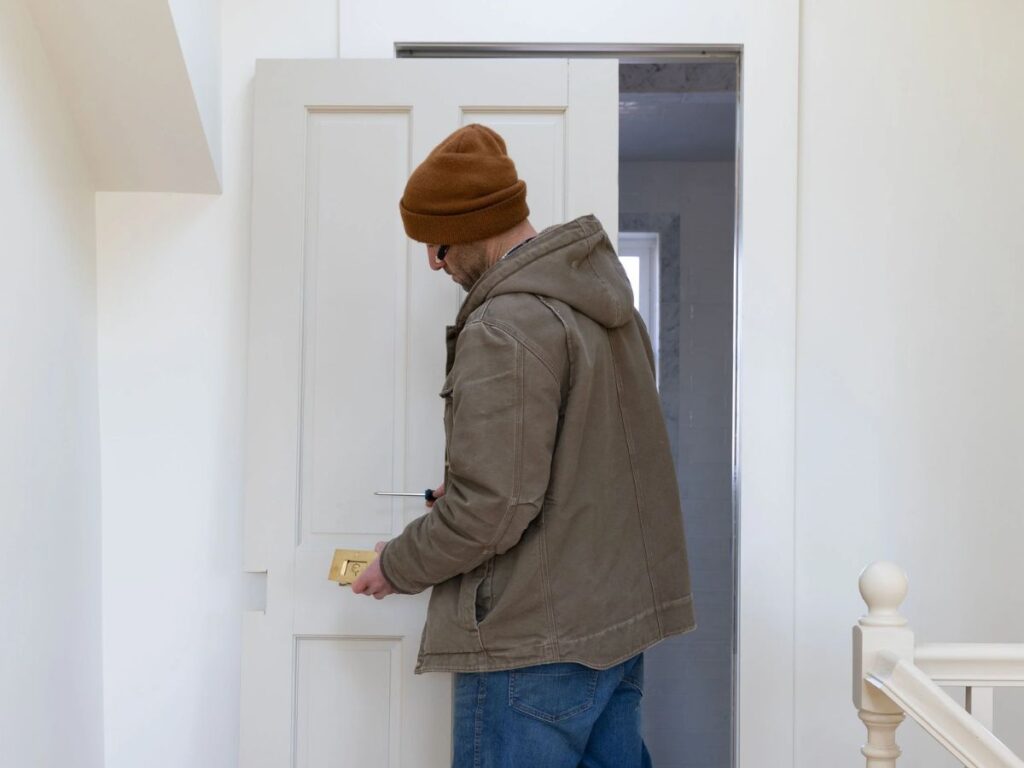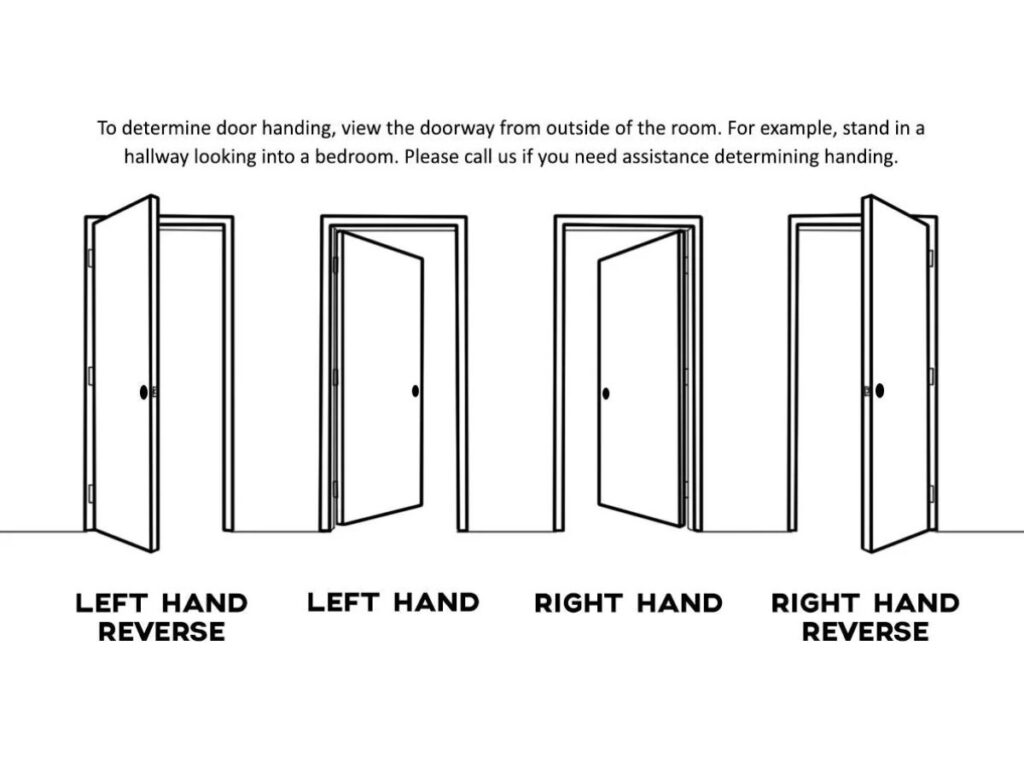I remember a villa project where the bathroom door swung right into the sink, leaving barely any space to move.
That’s when I realized how often door swing direction gets overlooked in planning.
My work involves supplying and advising on door installations for villas, hotels, inns, and B&Bs. I’ve helped many teams fix layout problems caused by incorrect swing direction.
This guide will show you how to determine door swing direction correctly from the start, so your layout works exactly as intended. You’ll get the answers you came for.
Get the swing wrong, and it’s not just awkward, it’s expensive.
So, let’s jump in!
1. What is Door Swing?
Door swing is the direction a door opens when you push or pull it. It can swing to the left or to the right, and it matters more than most people think. I’ve seen projects delayed because the swing was wrong, forcing teams to re-hang doors or even reorder frames.
Getting the swing right means the door works with the layout, not against it. It affects how people move through the space, where furniture or equipment can be placed, and even how safe the entry or exit is. Understanding door swing from the start can save time, money, and frustration later.
2. Tools and Aids to Help You Decide
Choosing the right door swing doesn’t have to be guesswork. Over the years, I’ve used a mix of simple tools and on-site checks to get it right the first time.
Here are the tools and aids I recommend.
Door Swing Chart
A door swing template is a paper or cardboard cutout that shows the arc of a door in different positions. You can place it on the floor plan or on-site to see how the swing will work with walls, furniture, or equipment.
I’ve used this in tight hotel rooms and small villa bathrooms where every inch counts. It’s quick, visual, and helps you decide in seconds whether a left-hand or right-hand swing works best.
Floor Plans with Swing Symbols
Most professional floor plans include symbols that show door swings, but they can be overlooked or misread. These symbols use curved lines to indicate the direction and range of the swing. Reviewing these details early in the design stage helps prevent layout conflicts.
A small adjustment on paper is far cheaper than re-hanging a door after installation.
Digital Design Software
For larger projects, digital design software such as AutoCAD or Revit is especially helpful. It allows a clear view of how the door interacts with the surrounding space in both 2D and 3D.
This tool can reveal conflicts between doors, hallways, and built-in fixtures before construction begins. It’s also useful when coordinating with architects and other trades.
3. Step-by-Step Guide to Determine Door Swing Direction
Determining door swing direction is simple once you know what to look for. I’ve worked on enough projects to see that most mistakes happen when people skip the basics. If you follow these steps, you’ll be confident in your choice before any installation starts.
Step #1: Stand Where the Door Will Be Installed
This is the first step when figuring out door swing direction. It gives you the best perspective on how the door will actually function in the space.
- Position Yourself on the Correct Side: Stand where the door will be used most often, whether that’s inside or outside. This helps you see how it fits with the room’s flow.
- Mark the Frame Location: Use chalk or tape to mark the spot where the frame will be set. This gives you a physical reference for the swing.
- Face the Opening: Stand in the position you’ll be in when opening the door. This makes it easier to judge hinge and handle placement. Vallisco doors are designed for precision fitting, so whichever side you choose, the hardware aligns perfectly for smooth operation.

Step #2: Decide on Push or Pull
Once you know your position, decide if the door should push away from you or pull toward you. I’ve learned that this choice often depends on space and safety needs.
- Review Building Codes: Some spaces, like public exits, require push doors for safety. Always check local regulations first.
- Think About Traffic Flow: In busy hallways or delivery areas, pushing might be smoother than pulling. This keeps movement efficient.
- Avoid Blocking Key Areas: Make sure the swing doesn’t block aisles, equipment, or furniture. This prevents daily use problems.
Step #3: Identify Left-Hand or Right-Hand Swing
Now it’s time to figure out which side the hinges belong on. The side determines whether the door is left-hand or right-hand swing.
- Stand in the Opening: Position yourself so the door opens away from you. This makes the hinge location clear.
- Check Hinge Side: If the hinges are on your left, it’s left-hand swing. If they’re on your right, it’s right-hand swing.
- Match to Industry Terms: Use standard terminology so suppliers and installers understand exactly what you mean.

Step #4: Test for Clearance and Obstructions
A door that hits furniture or walls will cause problems from day one. Testing for clearance now prevents expensive fixes later.
- Mark the Swing Arc: Use tape or chalk to show where the door will travel. This helps visualize the space it needs.
- Check for Interference: Look for furniture, built-ins, or structural features that could block the door. This avoids installation conflicts.
- Account for Door Thickness: Remember to factor in the handle and frame depth. These can affect clearance.
Step #5: Confirm with the Floor Plan or Mockup
The last step is checking your decision against the plans or a physical mockup. This makes sure your choice aligns with the overall design.
- Compare with Drawings: Look for door swing symbols and confirm they match your decision. This keeps the project consistent.
- Walk Through the Motion: Use a temporary setup to open and close the door as intended. This reveals any overlooked issues.
- Get Final Approval: Have the project manager or owner sign off before installation. This avoids changes later.
4. Common Mistakes to Avoid
Even with clear plans, I’ve seen door swing decisions go wrong because small details were overlooked. These errors can lead to delays, added costs, and unhappy clients. Here’s a table of common mistakes and straightforward solutions that work in real projects.
| Common Mistake | Solution |
| Choosing swing direction without checking the floor plan. | Always confirm with the latest approved drawings before installation. |
| Ignoring how the door interacts with nearby furniture or equipment. | Test the swing arc on-site to check for obstructions. |
| Mixing up left-hand and right-hand terminology. | Use industry-standard terms and diagrams to avoid confusion. |
| Forgetting to consider building code requirements. | Review local codes for safety, accessibility, and emergency egress. |
| Relying only on visual judgment without measuring. | Take accurate measurements of space, clearance, and swing arc. |
| Not involving key team members in the decision. | Discuss swing direction with the installer, architect, and owner before final approval. |
5. Factors to Consider When Choosing Door Swing Direction
Choosing the right swing direction goes beyond just deciding left or right. I’ve helped plan door installations for villas, hotels, and greenhouses, and the best results always come from looking at the full context of the space.
Here are some factors to consider when deciding:
Room Layout and Traffic Flow
The way people move through a space should guide your swing decision. A door that opens into the main walkway can interrupt the flow and create bottlenecks, especially in high-traffic areas.
In hotels or commercial spaces, this can frustrate staff and guests. Mapping out the typical movement in the room helps determine the side and direction that keeps traffic smooth. It’s one of the simplest checks you can make before committing to a design. Vallisco doors are built to operate smoothly in either direction, giving you flexibility without compromising performance or durability
Safety and Building Codes
Certain rooms or buildings have legal requirements for how a door must swing. Fire exits, for example, often need to open outward to allow quick evacuation. I’ve seen projects get held up because the swing direction didn’t meet accessibility rules for public buildings.
Reviewing the local code early can prevent expensive rework later. Always confirm with your local building authority before placing the order.
Furniture and Equipment Placement
Large furniture, shelving, or machinery can easily block a door’s swing path if not accounted for during planning. Even small fixtures like light switches or coat hooks can create usability issues if the door swings over them.
This is especially important in villas with built-in cabinetry or in greenhouses with fixed equipment. Measuring clearances and visualizing how the door will move ensures you avoid awkward collisions. I’ve found that a simple tape outline of the swing arc is a fast way to catch these problems early.
Function of Space
The purpose of the room plays a big role in deciding the swing. A delivery area may require the door to swing in a way that allows for quick unloading, while a private office might favor a swing that offers more privacy. Spaces with frequent two-way traffic may need a swing direction that allows for easy passing.
Considering how the door will be used daily helps you choose the most practical option. A functional decision here can save time and frustration for years to come.
Conclusion
I will never forget that villa remodel where the door blocked the light switch. It proved how one wrong swing can affect everyday use.
You now know how to choose the right direction by checking layout, safety, and functionality. This is no longer guesswork.
Every project benefits from doors that open the right way for the first time. Vallisco designs doors that fit your layout and keep traffic moving.
Contact us today and let us help with your next project.!
Explore Related Resources
If you enjoyed this read, here are a few more articles packed with helpful information:
Still haven’t found what you’re looking for? Don’t hesitate to contact us. We’re available around the clock to assist you.







